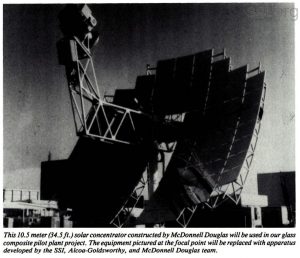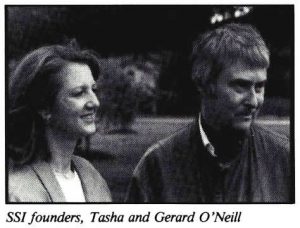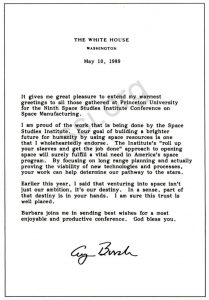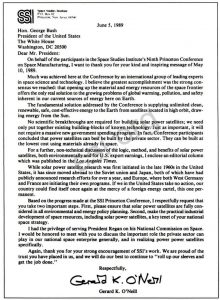“I am proud of the work that is being done by the Space Studies Institute. Your goal of building a brighter future for humanity by using space resources is one that I wholeheartedly endorse. The Institute’s ‘roll up your sleeves and get the job done’ approach to opening space will surely fulfill a vital need in America’s space program.”
– President George Bush (senior)
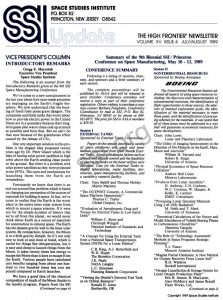
SPACE STUDIES INSTITUTE
P.O. BOX 82
PRINCETON, NEW JERSEY 08542
[[librarian note: This address is here, as it was in the original printed newsletter, for historical reasons. It is no longer the physical address of SSI. For contributions, please see this page]]
SSI UPDATE
THE HIGH FRONTIER® NEWSLETTER
VOLUME XV ISSUE 4 JULY/AUGUST 1989
VICE PRESIDENT’S COLUMN
INTRODUCTORY REMARKS
Gregg E. Maryniak
Executive Vice President
Space Studies Institute
The following is an excerpt from the Introductory Remarks given at the 9th SSI Space Manufacturing Conference
We’ve come to a new consciousness in the last year about how man-made processes are impinging on the Earth’s fragile biosphere. We now understand that the burning of fossil fuels poses grave dangers. The companies and think tanks that worry about how to provide electric power to the United States are in a quandary because their longterm game plan was to clean coal up as much as possible and burn that. But we can’t do that now because of the greenhouse effect caused by the release of CO2.
One very important solution to this problem is the elegant idea proposed twenty years ago by Dr. Peter Glaser which is the idea of having solar power satellites in high orbit above the Earth sending clean power to the ground. But there is a problem with solar power satellites as they were proposed in the 1970’s. The costs and mechanisms for launching them from the Earth are tremendous.
Fortunately we know that there is an end run around that problem which is based on changing our perception of the sources of materials for building in space. In fact, we’ve come to realize that the Earth is the worst place in the entire inner solar system from which to mount a space mission. If it were not for the simple accident of history that we’re all from this planet, we would never think about Earth as a source of materials for construction in cislunar space. The Earth has the deepest gravity well in the inner solar system. By comparison, however, the Moon is in a little gravity dimple. So it’s not only nice to look at and close at hand, which is useful for things like teleoperations, but it is easy and cheap to launch things from the Moon. It takes twenty times less energy to escape the Moon than it does to escape from the Earth. Various people have calculated cost benefits ranging from about one hundred to two hundred times less cost per pound compared to Earth launches.
We have a good idea of the chemical composition of much ofthe Moon thanks to the Apollo program. Papers from the SSI Space Manufacturing Conferences have showed ways to apply terrestrial mining techniques to the lunar surface. We know how to launch material from the Moon into space without chemical rocketry – with mass-drivers. The Space Studies Institute has been working on all of these aspects of space manufacturing.
We’re also working on relatively crude, simple techniques for processing materials into feedstocks for building in space. It may be that you don’t have to go down to the level of metals, for example, for making some very useful structures. We are just about to conclude an agreement with a major aerospace company and Alcoa/Goldsworthy Engineering with Brandt Goldsworthy. He has been developing glass composite materials – materials made of glass fiber embedded in a glass matrix. We’re going to take one of Goldsworthy’s glass machines and put it at the focal point of a dish in southern California and by the end of the year we hope to have an operational pilot scale lunar glass composite factory going. (See announcement below.)
We also have some very interesting smallscale experiments in using fused lunar soil for building materials and also fusing the lunar surface for site preparation of landing pads, roadways, and such. Joe Kennedy, an SSI Senior Associate and a student from I.S.U., is using a Fresnell lens supplied by SSI. He is working with the Nader Khalili of the Geltaftan Foundation who has worked on using fused soil construction primarily for the third world but also for lunar surface projects.
We’ve also talked about using translunar resources – the asteroidal resources. Our friends John Lewis and Andy Cutler pointed out that many of these objects have superior delta-V opportunities. However, it’s ironic that we’ve lost the best asteroid that we knew about: 1982 DB. These little plantesimals are not all that easy to see, but good work is going on in Arizona which leads me to think that we will find them and keep track of them and eventually move them around using mass-drivers.
By using space resources we can get away from the problem of the perception (which has always been wrong) that the Earth is a completely closed system. The Earth is not a closed system. It exists in space. It gets its energy from space and always has.
But most people do think about the Earth as a relatively closed system and by using nonterrestrial energy and nonterrestrial resources, we can dispel that myth.
Not only can we help the Earth, but we can also expand human activity and presence not only in the neighborhood of the Earth, Moon, and inner solar system, but well beyond it. Robert Forward and Freeman Dyson have proposed the idea of using one week’s output from a solar power satellite in its testing phase to propel a very small, very thin, very wispy solar sail. But instead of being pushed by sunlight pressure, this vehicle is pushed by microwave frequency light. It can be a very fine mesh because the wavelengths are much longer. A big Fresnell lens can help to concentrate the microwave energy. In just five days the output from a solar power satellite could accelerate this “starwisp” to 2/10ths. of the speed of light. That means that whoever is around when the first solar power satellites are built is likely to see the first television pictures from Alpha Centauri in their lifetime.
There are some important near-term projects that are going on right now. One of the most exciting ones is that the Space Studies Institute is about to release a Request for Proposals in the month of June for the design of a private lunar prospector probe to search for water ice which may be trapped at the poles of the Moon. It will also globally map the Moon. We only have data on the equatorial areas of the Moon from space and we need to know what the entire Moon is made of. Before this conference began, we had an intense two day workshop with people from Arizona, the Jet Propulsion Laboratory and from all over the United States, working on the specifications for this design.
We see an era when energy and material resources are used in space, where energy is transmitted to the surface of the Earth, and where people are involved in enterprise. Then we will begin to see true human expansion into the solar system, a very exciting prospect. That’s the way we’re headed and the work of all the different sessions of this conference is leading us in that direction.
Gregg Maryniak
Research Agreement Reached with McDonnell Douglas and Alcoa-Goldsworthy
The Space Studies Institute has signed an agreement with McDonnell Douglas and a division of Alcoa to demonstrate a solar powered pilot plant to produce fiberglass from simulated lunar material.
This research follows work which SSI has performed on processing lunar materials for nearly a decade with the California Space Institute, Goldsworthy Engineering and Rockwell International.
McDonnell Douglas, a leader in solar power technology will provide the solar concentrator and will operate the facility at its Space Systems Company in Huntington Beach, California.
Alcoa-Goldsworthy and SSI will provide the expertise in processing and analyzing the composites produced, as well as the actual simulant to be used in the experiments. Brandt Goldsworthy has conducted composite processing studies for NASA and the US Department of Energy. Under contract to SSI he has made fiberglass-like material from lunar simulant.
This research will show how to use simple and abundant lunar materials to make parts for space structures and lunar surface habitats.
Summary of the 9th Biennial SSI/Princeton Conference on Space Manufacturing, May 10 -13, 1989
CONFERENCE SUMMARY
Following is a listing of sessions, chairmen, and sponsors and a brief summary of each session.
The complete proceedings will be published by AIAA and will be released in early October. Conference attendees will receive a copy as part of their conference registration. Others wishing to purchase a copy may contact Barbara Faughnan, Conference Coordinator by mail at SSI or by phone at xxx-xxx-xxxx. The price for SSI or AIAA members is $39.50.
Session I: EXTERNAL TANKS
Sponsored by External Tanks Corporation
Papers in this session described a variety of space platforms and space and lunar habitats constructed from spent Shuttle External Tanks. Along with design factors such as attitude and altitude control and the feasibility of placing the tanks on the lunar surface were discussed. Uses for the External Tanks included laboratories, waste facilities, dormitories, space manufacturing facilities, and a variable-g research facility.
Chair: Faye Bailiff and Thomas Mobley
Martin Marietta
“The OUTPOST Concept, A Commercial Space Platform Opportunity”
Thomas C. Taylor
Global Outpost, Inc.
“Evaluation of Aerodynamic Drag and Torque for External Tanks in Low Earth Orbit”
William C. Stone and
Christoph Witzgall
National Institute of Standards and Technology
“A Concept for Using the External Tank from a National Space Transportation System (NSTS) for a Lunar Habitat”
C.B. King, A.J. Butterfield and
W.D. Hypes
The Bionetics Corporation
J.E. Nealy
NASA Langley
L.C. Simonsen
Planning Research Corporation
“Viewing the Shuttle’s External Fuel Tank as an Orbital Resource”
Ronald D. Jones
Bartlesville, OK
Session II: NONTERRESTRIAL RESOURCES
Sponsored by Boeing Aerospace
![]()
The Nonterrestrial Resources Session addressed all aspects of using space resources including: the discovery and characterization of extraterrestrial resources, the identification of flight opportunities to those sources, the selection of manned exploration goals, the identification of the material necessary to meet those goals, and the identification of processing schemes for the materials. It was noted that all ofthese areas must be addressed in a way that will guarantee economical resources for space development.
Chair: John Lewis
Lunar and Planetary Laboratory
“The Utility of Imaging Spectrometry in the Detection of Ore Minerals on the Earth, Mars, Moon and Asteroids”
William H. Farrand and
Robert B. Singer
University of Arizona
“Physical Economics of Space Resource Utilization”
Andrew Hall Cutler
Minerva Laboratories
“Products from Lunar Anorthite”
D. Anthony,
C.N. Cochran,
W.C. Cochran,
W. Haupin,
R. Keller,
K. Larimer
EMEC Consultants
“Processing Lunar Simulant Materials Using 2.45 GHz Radiation”
M. Nehls and T. Meek
University of Tennessee
“Theoretical Calculations of the Nature and Modal Abundances of Volatile Bearing Phases in Carbonaceous Chondrites”
Jibamitra Ganguly
University of Arizona
“The Role of ‘Technology Assessment’ Methods in Space Programs Strategic Planning”
V.I. Vlasov
Moscow Aviation Institute
“Magma Partial Oxidation: A New Method for Oxygen Recovery From Lunar Soil”
R.D. Waldron
Rockell International
“Oxygen Liquefaction & Storage System for Lunar Oxygen Production Plant”
Eric B. Jenson,
B. MacLaren,
Gary McMurry
and James Brazell
Pacer Works, Ltd.
“Silicon Production for the International Space University Lunar Base Design Project”
Marina Rodrigues de Aquiar
(This paper was-not presented, but will be included in the proceedings.)
Session III: SPACE MANUFACTURING AND SPACE POWER
Sponsored by AIAA

Harnesssing the energy of space was the central theme of the space power section of this session. Dr. Peter Glaser described a rationale for implementation of the use of space based solar power. He stated that at first we will see a harnessing of space power and the transfer of poWer between spacecraft, followed by the transfer between space and Earth. The use of nonterrestrial resources (lunar materials in particular) was stressed in the Space Manufacturing session. Teleoperations in the processing of the raw materials was featured in two of the papers, as well as in a display by Rob Lewis and Dave Brody (pictured on page 3)
Chair: Peter Glaser
Arthur D. Little Company
“SP-100, A Flexible Technology for Space Power for 10s to 1OOs of KWe”
Philip R. Pluta et al
General Electric
“Beamed Power Transmission and Transportation System in Equatorial Plane”
William C. Brown
Weston, MA
“Preliminary Lunar Teleoperations Investigations Using a Low Cost Mobile Robot”
Robert H. Lewis
Space Studies Institute
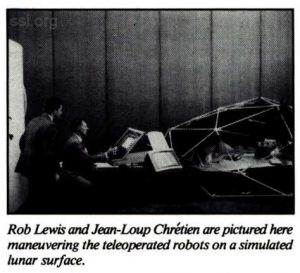
“Near-Term Nonterrestrial Materials Usage in Solar Power Satellites”
Brian Tillotson
and Paul Dubose
Space Research Associates, Inc.
“Solar Power Satellites and the Developing Nations of the World”
Rashmi Mayer
Urban Development Institute
“Lunar Production of Solar Cells: A NearTerm Product for a Lunar Industrial Facility”
Geoffrey A. Landis
NASA Lewis Research Center
Maria A. Perino
Aeritalia
“A Survey on the Future of Space Solar Power”
Todd B. Hawley
International Space University
“Further Developments in Very Large Truss Construction in Space”
Anthony P. Coppa
General Electric-Astro Space
Session IV: INTERNATIONAL AND ECONOMIC CONSIDERATIONS
Sponsored by the Geostar Corporation

The papers in this session demonstrated the progress made in the understanding of the economics of the space environment, and our ability to work in it, while acknowledging that the incentive for private sector investment is currently limited. The importance of international involvement and cooperation was theme of several of the papers.
Chair: Irwin Pikus
U.S. Department of Commerce
“Political, Economic, and Legal Considerations in International Cooperation on Lunar Use and Exploration”
Ronald S. McCandless
Naval Surface Warefare Center
Lori Garver
National Space Society
“Technology Transfer in Space-Related Joint Ventures”
Johanna M. Klema and Donald Dalton
U.S. Department of Commerce
“Space Debris, Universal Killer”
Hon. Edward R. Finch, Jr.
New York, NY
“New Initiatives in Technology and Enterprise”
Kyle Fairchild
NASA Johnson Space Center
“Entrepreneurial Space Business”
Brian Kirk
Geostar Corporation
“Funding the High Frontier: Old Lessons We Must Once Again Learn”
James E. Dunstan
Haley, Bader & Potts
“Macro-Projects in Space: The Prospects for International Cooperation in the 1990s” Michael A.G. Michaud
US Department of State
“Commercial Infrastructure Participation in the Space Studies Freedom Program”
Kevin Barquinero
NASA
Jeffrey S. Cassidy
The Egan Group
POSTER SESSION
Sponsored by OMNI Magazine

The Poster Session provided an opportunity for participants to present their papers at a wine and cheese reception, as well as at specified times.
Chair: James Burke
Jet Propulsion Laboratory
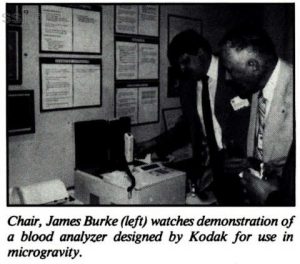
Lunar Polar Probe Workshop Summary Session
Chair: Gay Canough
ExtraTerrestrial Materials, Inc.
This session summarized the results ofthe 1989 SSI Lunar Prospector Workshop on designs for a low cost dedicated probe to search for frozen volatiles at the Moon’s poles.
Session V: SPACE BIOSPHERES
Sponsored by Space Studies Institute

The central theme of this session linked the use of the tools and techniques for space life support systems to the insights that will be provided into the understanding and managing of the Earth’s biosphere. Specifically, the session addressed the development of the closed ecological systems and the emergence of a science of biospherics.
Chair: Mark Nelson
Institute of Ecotechnics
“A System for Recycling Organic Materials in a Microgravity Environment”
Judith A. Field
and Nicholaus Leggett
Washington, DC
“Bioregenerative Space and Terrestrial Habitat”
B.C. Wolverton,
R.C. McCaleb, and
W.L. Douglas
NASA-Stennis Space Center
“CELSS Breadboard Project: 1988”
W.M. Knott,
J.C. Sager,
R.P. Prince,
J.D. Jones
NASA Kennedy Space Center
“Controlled Ecological Life Support System Breadboard Project: 1988”
W.M. Knott,
J.C. Sager,
R.P. Prince,
J.D. Jones
NASA Kennedy Space Center
“Human in Closed Ecosystem Experiments”
Linda Leigh
Space Biospheres Ventures
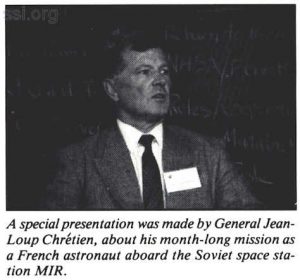
“Methods of Creating Biological Life Support Systems for Man in Space”
Josef Gitelson
Institute of Biosphyrics,
USSR
Showing of USSR film:
Documentary Film on the Tios-3 Facility Experiment in Closed Ecological Systems in Krasnoyarsk, Siberia, USSR for a low cost dedicated probe to search for frozen volatiles at the Moon’s poles.
Session VI: SPACE TRANSPORTATION
Sponsored by Arianespace, Inc.
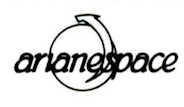
All aspects of space transportation were discussed in this session. Specifically addressed were: the delivery of people and/or cargo from Earth to low-Earth orbit,· transfer between low-Earth orbit and geosynchronous orbit, the libration points, orbits around the Moon, platforms, stations and planet surfaces. The problem of space debris and its danger to space transportation vehicles and personnel was also explored. It was noted in many of the presentations that low-cost reliable space transportation is a key to economical space development and exploration.
Chair: Ed Bock
General Dynamics
“Recent Results from an Enhanced MD-III Simulation”
Les Snively
Space Studies Institute
“Concept For a Lunar 3He Transporter Using an In-Orbit Modified Shuttle External Tank”
A.J. Butterfield
and J.W. Goslee
NASA – Langley
“The Nature of Space Debris and How to Clean It Up”
Gay Canough and L.P. Lehman
ExtraTerrestrial Materials, Inc.
“How a Nuclear-Oxygen Lunar Shuttle Can Help Us Beat The Fuel Bottleneck in Early Lunar Exploration and Space Build-Up”
Daniel J. Connors
Warner Robins, GA
“Logistic Support Analysis for Mars Class Missions”
William C. Lewis
Grand Valley State University
and Research and Technology Institute of Western Michigan
“Astrodenture: Taking Bites of Green Cheese Without Landing on the Moon”
Brian Tillotson
Space Research Associates, Inc.
Session VII: LUNAR BASES
Sponsored by Cheseborough-Ponds, Inc. Research Laboratories

The Lunar Bases Session Was added as a session of the SSI/Princeton Conference on Space Manufacturing this year to address the specific technologies and problems associated with establishing a lunar base. Presentations in this Session described the handling of the payloads of the mass-driver once it has escaped the gravity of the Moon, the possible power sources to power the lunar base through the lunar night, a modeling tool for developing and ranking the concepts for lunar base construction, the selection process of choosing a location for a lunar base and its basic operation, and a summary ofthe lunar base design work completed in the Summer of 1988 at the International Space University.
Chair: Wendell Mendell
NASA Johnson Space Center
“A Lunar Propellant Supply System”
Patricia Buddington,
Brent Sherwood,
and Benjamin Donahue
Boeing Aerospace – Huntsville
“Solar Power for the Lunar Night”
Geoffrey A. Landis
NASA Lewis Research Center
“Evaluation of Lunar Base Structures”
H. Benaroya,
M. Ettouney,
J. Wright
Weidlinger Associates
“Site Selection for a Lunar Base”
Alice Eichold
Yale University
“The International Lunar Initiative: The 1988 Design Project of the International Space University”
Todd Hawley and
Peter H. Diamandis
International Space University
Session VIII: BIOMEDICAL CONSIDERATIONS
Sponsored by International Space University

The papers in the Biomedical Session covered a variety of space life science issues ranging from futuristic architectural health facility projections. to artificial gravity considerations, and the latest research on the various physiologic systems effected by space travel.
Chair: James Logan, M.D.
NASA Headquarters
“Physiological Parameters of Artificial Gravity”
Rex Schultheis, MD
The Johns Hopkins Hospital
“Anesthesia in the High Frontier”
Erik T. Paterson
University of British Columbia
“Multiple Vehicle Low-Orbit Bases Mobile Emergency Trauma Hospital”
Todd Brickhouse
Hygenia Home-Care, Inc.
“Selection of Atmospheric Pressure for a Lunar Base: A Trade-off Study”
Anna E. Petropoulos
International Space University
“Zero-G Dwellers: Human Development and Growth in Microgravity”
Peter H. Diamandis
International Space University
BANQUET
Sponsored by GE Astro and General Dynamics

Dr. Robert Cenker of GE Astro addressed the conference participants at the Conference Banquet. He described his adventures aboard the Space Shuttle as a mission specialist.
Following the close of the conference on Saturday, SSI hosted a box lunch picnic at their headquarters. Dr. and Mrs. O’Neill are pictured here at the picnic.
CLOSING REMARKS
Gerard K. O’Neill
President, Space Studies Institute
The coming of age of the SSI/AIAA Conferences is illustrated by many things. One of them is the list of sponsors for the Conference. It is many times longer than it has every been before, and a very distinguished list it is.
AIAA
Arianespace
Boeing Aerospace
Cheseborough Ponds’s Inc.
External Tanks Corp.
General Dynamics
GE Astro Space
Geostar Corporation
International Space University
OMNI Magazine
Rockwell International
There are a few points that I would like to make as a personal opinion, not only about the Conference but about all of the work that we are doing together.
First, I believe quite firmly that in the decades immediately to come there is a key issue which will affect all space programs internationally:
The major nations of the world will be facing very serious issues of economic competitiveness. I believe that it is going to be extremely difficult for any nation to support any large scale space program unless it has a practical application. That application and the corresponding benefit must be genuine, continuing, of large scale, and must have an immediately perceivable positive effect. I think also that the application must be something which can be expressed in one sentence. An example, which I’ll return to again in a few moments, is satellite solar power to supply clean energy to the world, and also to allow cleaning up the biosphere of the Earth.
I’ve been struck by the changes that have occurred in the perception of space during the two years since our last biennial Conference. The first and most important of those changes is increasing internationalization. Simply to give a few examples: there was last year the successful test of the large Energia launch vehicle by the USSR, and there has also been the successful first flight of the Buran Shuttle by the Soviets. Here I think a parenthetical aside is in order – whatever chauvinism we Americans may have, the Russians really did learn from our mistakes; the Buran is, from the point of view of fundamental design, whatever may happen to it in the future, a much better vehicle than the Space Shuttle. The fundamental change, a great improvement, is that the Buran does not have any main engines to lug back to a landing. It’s also a more sophisticated vehicle, in the sense that it is totally automated flyable from lift off to landing without requiring any astronauts on board. That is a plus, not a minus.
In addition there’s an interesting relatively small space glider or reentry vehicle which the Soviets have successfully demonstrated. That is a very important foretaste of the future, which is paralleled by the Hermes space plane that has now been approved for construction by the European nations, to be launched on Ariane 5 within the 1990s. And the Japanese have finally come out of the woodwork and admitted that they’re going to have a manned space program. That manned program is based on the Hope space plane, which again is a small glider or reentry vehicle. All three of the vehicles, none of them U.S., do the sensible thing – return to the Earth the only payloads that really have to be returned namely people and data packages. The Energia, the Buran, and the three reentry gliders are all developments that are firmly underway, and in the case of the first two, already completed.
In this country, reasonably firmly underway more for military reasons than for civil reasons, is the National Aero Space plane. It is ambitious, large scale, and long term; but it will, I think, quite likely prove to be a success in the long run. However, don’t expect it soon. The National Aero Space plane is a very, very difficult and ambitious undertaking – in many ways far more sophisticated and ambitious than was the Shuttle back in 1970; and it is already clear in retrospect that the Shuttle program was too ambitious a project to undertake at that time. Certainly its net effect over 20 years has been destructive, in its cancellation and actual destruction of the successful expendable launch vehicles which the U.S. had. That was a disastrous mistake of the U.S. space program.
By contrast, on the positive side, new developments within the past two years are that the ideas of nonterrestrial material usage – living off the land – as one gets into space, and the ideas of construction in space from nonterrestrial materials, are clearly becoming more complete and detailed, and are more and more being accepted as mainstream ideas. Ten, fifteen or twenty years ago they were very far out indeed.
An interesting project on which SSI has been particularly active within the past two years, and on which it will be active for over the next several years, you have certainly heard about. That is the lunar polar probe, a key and pivotal mission to be carried out within the next few years, at a very small budget, and done primarily as a private venture. It is a project for a few million dollars to send a space probe over the poles of the Moon to look down into the permanently shadowed lunar craters, to find out whether there are in fact frozen volatiles, including water-ice, that have been trapped there by meteoritic bombardment over the course of many years. Those volatiles are probably still there, because the temperature in those cold traps is close to absolute zero. Whether the volatiles are on the Moon or not is one of the most fascinating questions in all of planetary science, and I believe that there’s a good chance that we will be carrying out a mission within the next few years, to try to settle that question.
The Conferences, as I noted earlier, are certainly coming of age. The distinguished set of sponsors, conferees and speakers at this conference bears that out. You have been at the Conference, so it’s not necessary for me to belabor that point. More and more, what is being talked about at these Conferences is paralleled by what new initiatives in the space programs of the U.S., the USSR, Eruope and Japan, while we at SSI find ourselves holding to the same consistent program that we have been for many years. The difference now is that other people are now singing our tune.
I’d like to repeat, if I may, a couple of paragraphs from the remarks that I made in opening the Conference. They relate to the necessity for a practical application and benefit which is genuine and has a time scale valid for a long duration. Those conditions are necessary if there is to be, as we all wish, an expanding multinational space program. There are two changes in viewpoint on space development which have occurred that are new since the Conference of two years ago. One is a widening consensus that all missions beyond Earth orbit should begin with activity on the Moon, whether that be for material processing to build solar power satellites or for construction of a complete lunar base. The second is a drive toward large scale manufacturing in space, something which was not widely accepted as little as two to three years ago.
In the world outside the space community, there is a growing disaffection with nuclear power, combined with a sudden awareness that the greenhouse effect is real. This was brought home to me by a conversation with Dr. Jay Keyworth, now of the Hudson Institute, who was for five years President Regan’s Science Advisor. While in that post he was of great help to me in the critical issue of obtaining the frequency allocations for the Geostar Corporation, which is of course closely associated with SSI. Dr. Keyworth was our Keynote Speaker at one of the SSI Conferences. A month ago, when I showed Dr. Keyworth articles I had written for the Washington Times and the Los Angeles Times, advocating control of the greenhouse effect by the replacement of burning fossil fuels over the next several decades by supplying clean energy to the Earth from solar power satellites, he went over the numbers, and then remarked:
I’m in support of the Satellite power concept, now that I know the numbers. Never before in my scientific career have I seen an issue over which virtually all scientists agree. That issue is the reality of the greenhouse effect, and the urgent need to switch from burning fossil fuels to obtaining energy in a clean way…
That quote from Dr. Keyworth, who is certainly in a position to keep his finger on the pulse of scientific opinion worldwide, is just one of many indicators that our consistent drive toward satellite power is gaining momentum. I feel that the view of the world’s needs by those outside our community of dedicated researchers is in fact changing, and changing in our direction.
Finally, those of you who were at the banquet last night listened to the supportive, inspiring, well written message from President Bush to the Conference and to SSL Several people suggested to Gregg Maryniak, and the SSI staff, that we respond in some way. I have agreed with them that we should in fact send President Bush a letter in response, on behalf, if you will permit us, of the participants of this Conference. We are all agreed that the letter should include four points: First, that we reached in this Conference a strong consensus that opening up the resources of the space frontier offers the best solution to the growing problems of global warming, pollution, and safety, inherent in our current sources of energy here on Earth.
Second, that while we feel it is important to use the unique vantage point space offers to study Earth’s environmental problems, we know that even many environmental experts are as yet unaware of the critical role space in general and solar power satellites made from resources already in space specifically can play in solving these problems. SPS therefore is what we would call the ultimate mission to planet Earth: a mission to save the planet Earth.
Third, that the common thread of our discussions was that opening the High Frontier, and developing this new energy source, can be accomplished far more quickly and efficiently by encouraging the imagination and the innovation of our private sector.
And finally, based on the progress that we made here, to ask President Bush to do two things, first – to insure that solar power satellites are fully considered in all environmental, and energy planning decisions; and second, to make the commercial development of space resources a key tenet of his national space strategy. May I have the approval of our conference in writing a letter to that effect?
Gerard K. O’Neill
Conference attendees agreed by acclamation. As a result the following letter was sent to President Bush.
THE WHITE HOUSE
WASHINGTON
May 10, 1989
It gives me great pleasure to extend my warmest greetings to all those gathered at Princeton University for the Ninth Space Studies Institute Conference on Space Manufacturing.
I am proud of the work that is being done by the Space Studies Institute. Your goal of building a brighter future for humanity by using space resources is one that I wholeheartedly endorse. The Institute’s “roll up your sleeves and get the job done” approach to opening space will surely fulfill a vital need in America’s space program. By focusing on long range planning and actually proving the viability of new technologies and processes, your work can help determine our pathway to the stars.
Earlier this year, I said that venturing into space isn’t just our ambition, it’s our destiny. In a sense, part of that destiny is in your hands. I am sure this trust is well placed.
Barbara joins me in sending best wishes for a most enjoyable and productive conference. God bless you.
George Bush
June 5, 1989
Hon. George Bush
President of the United States
The White House
Washington, DC 20500
Dear Mr. President:
On behalf of the participants in the Space Studies Institute’s Ninth Princeton Conference on Space Manufacturing, I want to thank you for your kind and inspiring message of May 10, 1989.
Much was achieved here at the Conference by an international group of leading experts in space science and technology. I believe the greatest accomplishment was the strong consensus we reached: that opening up the material and energy resources of the space frontier offers the only real solution to the growing problems of global warming, pollution, and safety inherent in our current sources of energy here on Earth.
The fundamental solution addressed by the Conference is supplying unlimited clean, renewable, safe, cost-effective energy to the Earth from satellites located in high orbit, drawing energy from the Sun.
No scientific breakthroughs arc required for building solar power satellites; we need only put together existing building-blocks of known technology. Just as important, it will not require a massive new government spending program. In fact, Conference participants concluded that power satellites can best be built by the private sector. They can be built at the lowest cost using materials already in space.
For a further, non-technical discussion of the logic, method, and benefits of solar power satellites, both environmentally and for U.S. export earnings, I enclose an editorial column which was published in the Los Angeles Times.
While solar power satellite research was first initiated in the late 1960s in the United States, it has since moved abroad to the Soviet union and Japan, both of which have had publicly announced research efforts for over a year, and Europe, where both West Germany and France arc initiating their own programs. If we in the United States take no action, our country could find itself once again at the mercy of a foreign energy cartel, this one permanent.
Based on the progress made at the SSI Princeton Conference, I respectfully request that you take two important steps. First, please ensure that solar power satellites arc fully considered in all environmental and energy policy planning. Second, make the practical industrial development of space resources, including solar power satellites, a key tenet of your national space strategy.
I had the privilege of serving President Regan on his National Commission on Space. I would be honored to meet with you to discuss the important role the private sector can play in our national space enterprise generally, and in realizing power power satellites specifically.
Again, thank you for your strong encouragement of SSI’s work. We are proud of the trust you have placed in us, and we will do our best to continue to “roll up our sleeves and get the job done.”
Respectfully,
Gerard K. O’Neill
©space studies institute

